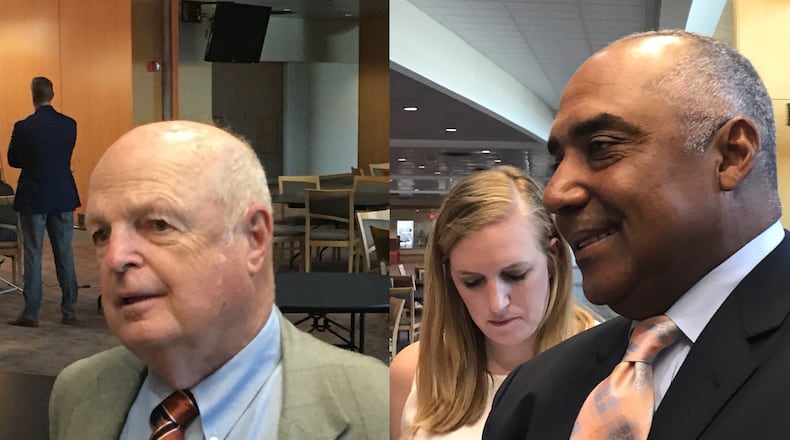»RELATED: Brown, Lewis in no rush on contract extension
Brown spoke about sticking with one player who has been in trouble off the field (cornerback Adam Jones) and acquiring another (running back Joe Mixon) while also looking forward to getting a full season out of embattled linebacker Vontaze Burfict, who has had trouble controlling himself between the lines.
Not surprisingly, the owner didn’t sound too concerned about outside perception of those moves.
Likewise, Lewis said he’s not worried about being on the last year of his contract to be the team’s coach. Everyone is on de facto one-year deals in the NFL, he reasoned, and he knows Brown well enough to know what his boss expects.
Brown will keep doing things his way, and Lewis will continue to adapt while putting his own stamp on the men in stripes.
Big Ten football media days, Bengals and more get going this week https://t.co/5tRzWrI17Z
— Marcus Hartman (@marcushartman) July 24, 2017
The consistent approach was key to recovering from a losing season in 2010 to post six straight playoff appearances, and they sound determined to mostly stay the course while trying to start another streak this fall after a 6-9-1 campaign last season.
But nearly everyone who pays attention to the NFL can recite another Bengals postseason fact from recent times, too: They haven’t won a playoff game since January 1991.
That begs an obvious question, especially in a league where change being the only constant because a cliché because it’s true:
If doing things a certain way has made the Bengals frequent postseason qualifiers, has it also prevented them from winning once they get there?
That’s the million-dollar question, though everyone has their suspicions.
The old O-HI-a River is pretty muddy, but it's a beautiful day in Cincinnati pic.twitter.com/hEc7cs47w0
— Marcus Hartman (@marcushartman) July 25, 2017
Of course, every game comes down to something different, and you’ve got to make the playoffs to lose there, right? There’s little doubt Lewis’ teams haven’t all reached their ceilings, but the 2000s and ‘10s still beat the hell out of the 1990s.
While the Bengals weren’t really supposed to win a couple of those playoff games, they flatly choked away at least a couple more.
Injuries put them behind the eight-ball more than once, but they were still headed toward a win over the Steelers two years ago before an infamous meltdown (involving Jones and Burfict, coincidentally or not).
And so Cincinnati enters 2017 relying on continuity again. Would Brown and Lewis have it any other way?
They lost some key free agents, including stalwart linemen Andrew Whitworth and Kevin Zeitler on offense and Domata Peko on defense, and plan to rely on mostly players who were already in the building to fill their shoes.
That’s part of the Bengals way, too.
It didn’t work so well last year, but that doesn’t seem to have caused them to rethink much.
Despite an aging defense and a leaky offensive line weakened further by the aforementioned defections, the Bengals went for offensive playmakers in the first and second rounds of the draft.
That kept with their policy of drafting the best player available (BPA) when it’s their turn, one they hope also pays off this fall with Cedric Ogbuehi and Jake Fisher this fall.
Bruton retires over trauma concern; former Miamisburg great.https://t.co/qyQybGoR2A@daytonsports @D_Brut30 @DavidPJablonski @marcushartman pic.twitter.com/wnvx2M1U0x
— Marc Pendleton (@MarcPendleton) July 25, 2017
Lewis pointed out the “BPA” draft mantra is what led them to take Ogbuehi and Fisher in 2015, a much happier time for the Bengals offensive line. No doubt it was key in taking Washington receiver John Ross and Oklahoma running back Joe Mixon with their first two picks in April, too.
The idea, the coach explained, is to build the best roster long term – a plan only possible with some job security.
“Continuity has been the success of a lot of organizations because you don’t have to restart,” Lewis said. “You’re looking at different players – and different kinds of players (when there is a coaching change). You’re re-starting scheme and that player you drafted two years ago now no longer works, so you’ve wasted an entire (draft year). It’s hard for teams to keep up that continually change.”
Despite their postseason frustrations, the Bengals are a franchise many others in the NFL have been trying to catch for the better part of a decade.
Then came last year.
While that be the new trend, or could it catapult Cincinnati even higher?
Faced with the prospect of starting over or doubling down on what they knew, Brown and Lewis chose the latter.
We’re about to find out if they were right.
About the Author

